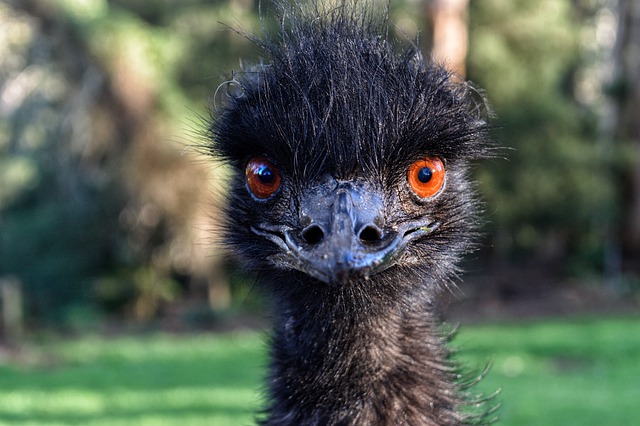
A team of researchers in Iran has lost a 2018 paper on using emu oil to prepare stem cells because they tried to recycle previously published images.
The journal told us that a whistleblower had raised concerns about the article, prompting an involved back-and-forth with the authors and even efforts at accommodation before the eventual decision to pull the paper.
The article, “A biomimetic emu oil-blended electrospun nanofibrous mat for maintaining stemness of adipose tissue-derived stem cells,” appeared in Biopreservation and Biobanking. According to the abstract:
Emu oil (EO) with anti-inflammatory, antioxidative, and wound healing properties can be blended for preparing bioactive nanofibrous scaffold. Adipose tissue-derived stem cells (ADSCs) are promising candidates for tissue engineering, and preserving their stemness potential is vital for further therapeutic applications. … These results demonstrate that the EO-blended nanofibrous mat can be used as a bioactive scaffold to support cell adhesion and proliferation while simultaneously maintaining the stemness of ADSCs.”
The paper has been cited six times, according to Clarivate Analytics’ Web of Science. But evidently some of the figures the researchers, from Tabriz University of Medical Sciences, had used to make their case were retreads. Here’s the notice:
Biopreservation and Biobanking is officially retracting the article entitled, A Biomimetic Emu Oil-Blended Electrospun Nanofibrous Mat for Maintaining Stemness of Adipose Tissue-Derived Stem Cells, by Jalilzadeh-Tabrizi S, Pilehvar-Soltanahmadi Y, Alizadeh E, Alipour S, Dadashpour M, Nejati-Koshki K, and Zarghami N (Biopreservation and Biobanking 2018;16(2);66–76. DOI: 10.1089/bio.2017.0056) due to the submission of the same images to different journals for different purposes, but without any attribution, reference, or reproduction permission.
The article had at first been corrected to include an added reference, but that initiated a further assessment by the editorial leadership. The findings of that added evaluation proved that no permission had been sought or granted to reproduce previously published work, nor was there any stated acknowledgment that the image appeared in previously published material. Therefore, the decision was made to retract the article from the scientific literature.
Biopreservation and Biobanking is dedicated to upholding the highest standards of peer review and does not tolerate any improprieties.
Sarah Jensen, the director of Editorial Services and Peer Review at Mary Ann Liebert, which publishes the journal, told us:
the decision to ultimately retract this article was based on an anonymous complaint which triggered an investigation by our ethics editor. Originally, we had hoped it was going to be a matter of a straightforward correction due to an honest mistake made on the authors’ part, but after our ethics editor evaluated the complaint and all of the associated relevant details, including other published papers, the decision was made to retract the paper instead of correcting it.
The evaluation by our ethics editor determined that the authors had indeed reused figures from at least seven different prior papers without properly citing the previous works. Part of the problem, we believe, stemmed from multiple submissions to different journals, undergoing review and/or revisions simultaneously, but with no declaration made to that effect to each journal editor, which is a clear violation of proper protocols and best practices for peer-reviewed journals. We believe that the “whistleblower” contacted the editors of those journals in which the other papers had been published, and that at least one of those journals contacted the author(s) of the paper asking for clarification, which triggered the authors’ email to [editor] Dr. [James] Vaught’s office requesting that correct attributions be added to the published paper.
I would also like to share with you a statement made by the whistleblower in the original complaint: “The same yet inconsistent date of imaging and various overlapping sections sometimes shown with different magnifications, indicates that these authors have an archive of figures and they use the same figures as new data in different paper . Needless to say, this data duplication severely affects the results reported in these papers.” All of these details were what led to the decision to retract the paper. It should be noted, too, that the authors appealed that decision, but Dr. Vaught denied the appeal.
About that correction mentioned in the retraction notice. In fact, the change never did occur, according to Jensen, who expressed regret about the confusing wording of the notice. She said the journal would be adding a notice clarifying the statement.
In response to our query about the article, Nosratollah Zarghami, the senior author of the paper, told us:
You need to know, as soon as finding out the forgotten in text citation in this paper, I voluntarily cooperated with the journal and its editor (Dr. Jim Vaught) dated June 12, 2019 to honestly address the proper citation in the paper as quickly as possible. Fortunately, with the help of editor, the article was corrected and the reference number 17 (Available in reference list; Pilehvar-Soltanahmadi et al 2017-https://doi.org/10.1016/j.yexcr.2017.05.015) was added to the Fig1 and Fig 2 (please see the final version of the published paper as the attachment 1). After about 2 weeks, unfortunately, the journal decided to retract this article according to an anonymous complaint without giving a chance to the authors to have a full response to the allegations. At this moment, we all authors are in shock because of the decision.
Like Retraction Watch? You can make a tax-deductible contribution to support our work, follow us on Twitter, like us on Facebook, add us to your RSS reader, or subscribe to our daily digest. If you find a retraction that’s not in our database, you can let us know here. For comments or feedback, email us at [email protected].
Good on Mary Ann Liebert and their staff for upholding scientific integrity. This kind of unchecked reuse of figures, text and so on (plagiarism and/or duplication) must be taken seriously. Indeed, it is not only often against various copyright laws and established scientific ethics, but the undocumented reuse also highlights the inherent lack of novelty of the manuscript.